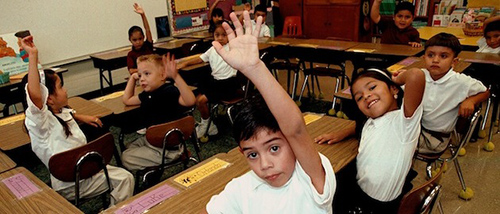Here’s a new report from NCES; it has a lot of data points on U.S. public school demographics between here and 2022, and this, summarized in Quartz, might be the most interesting: this fall, Hispanics + Asians + African-Americans + Native Americans + multi-racial individuals (in sum, “minorities”) will account for 50.3% of public school students in America. It’s 48% in high school and 51% from Pre-K to 8th grade.
Overall, the United States is classified as 62% non-Hispanic white (as of 2013), but if you take that number and you factor in the 51% number above … the U.S. is clearly trending towards a place where the conventional “majority” becomes the “minority.” At this point, that’s supposed to happen by 2043.
The fact that it’s already happening in public schools is both (a) amazing and (b) troubling, all at once.
It’s amazing because the notion of America as “melting pot” and “land of opportunity” is honestly reflected in this statistic, at least to some extent.
It’s troubling because, broadly-speaking, Hispanics and African-Americans and Native Americans trend academically behind (and sometimes far behind) white and Asian students. If they’re becoming the predominant aspects of public schooling, that might challenge teachers more — or, at the very least, make it necessary to have better teachers. That’s a hard sell sometimes because of compensation models and also because we (as a nation, America that is) tend to over-politicize the education space and confuse the issue. (If you don’t believe me on that, that’s all good — but hey, I did used to be a teacher!)
There’s also this whole context around minorities potentially getting tougher punishments in school:
And of course, as one might expect, the situation in private schools is pretty different. Per Pew:
The composition of the private school student population is markedly different. In 2009, about seven-in-ten (73%) of the estimated 4.7 million children enrolled in kindergarten through grade 12 in private schools were white.
Just an aside there: I’m white, and I grew up on the Upper East Side of Manhattan (fairly regularly, it’s one of the more affluent parts of the country). My parents themselves were not super affluent for the area (for America, sure), but I always went to private schools. Based on those experiences, I’d almost assuredly send any child of mine to a public school. I think it actually gives you a lot more context on the world and your neighborhood than a private school, which tends to be a much more insular-type place.
There’s also this, from Pew, with an additional thought from Moi:
While those born in the U.S. are driving growth, immigrants are still having an impact in the classroom. Across the country, school districts have had to boost English language instruction for students who are not native speakers. This is because seven-in-ten school-age children who are immigrants or have immigrant parents speak another language other than English at home and will likely be provided English language instruction upon entering school.
If you talk to people who travel a lot, it’s always interesting — the U.S., for how important it is in terms of military might and economic stability and natural resources and all that? It’s an incredibly insular place in terms of people having exposure / access to other cultures. This is a little different if you’re from Miami (my wife is) or from Topeka (sorry, just picked a random “flyover” city), sure — but still, you’ll meet people in Miami that know nothing about other cultures (and you’ll meet people in Topeka who know a ton).
The point is, I actually think it’s a good thing that the numbers are trending up on minorities in public schools. More white Americans could use that additional context on other cultures, languages and experiences. Hell, I think it would be good if we could find the money to shift some of those mid-to-high performing minorities (academically, that is) over to the private school side.
